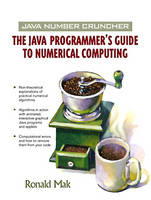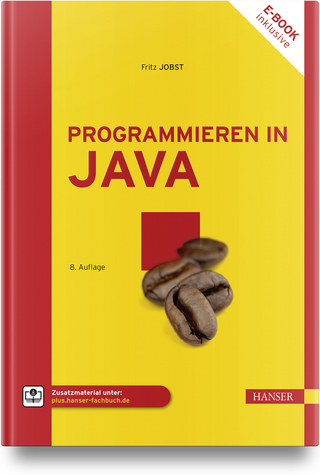
Java Number Cruncher
Prentice Hall (Verlag)
978-0-13-046041-7 (ISBN)
- Titel ist leider vergriffen;
keine Neuauflage - Artikel merken
This book introduces Java programmers to numerical computing. It contains clear, non-theoretical explanations of practical numerical algorithms, including safely summing numbers, finding roots of equations, interpolation and approximation, numerical integration and differentiation, and matrix operations, including solving sets of simultaneous equations. Many of the programs are applets that take advantage of Java's interactive graphics capabilities. These programs allow the user to interact with them as they dynamically demonstrate the computational algorithms in action. Java Number Cruncher devotes several chapters to searching for patterns in the prime numbers, generating random numbers, intriguing formulas for pi and e, arbitrarily long numbers and their relationship to data encryption, and algorithms for creating fractal images. Working Java programs demonstrate all the concepts from this book.
RONALD MAK is a senior scientist at the Research Institute for Advanced Computer Science, located at the NASA Ames Research Center in California. He is currently designing Java-based enterprise software for the next Mars rover mission. He has degrees in the mathematical sciences and in computer science from Stanford University. His two previous books were on compiler writing.
Preface.
How to Download the Source Code.
I. WHY GOOD COMPUTATIONS GO BAD.
1. Floating-Point Numbers Are Not Real!
Roundoff Errors. Error Explosion. Real Numbers versus Floating-Point Numbers. Precision and Accuracy. Disobeying the Laws of Algebra. And What about Those Integers?
2. How Wholesome Are the Integers?
The Integer Types and Operations. Signed Magnitude versus Two's-Complement. Whole Numbers versus Integer Numbers. Wrapper Classes. Integer Division and Remainder. Integer Exponentiation.
3. The Floating-Point Standard.
The Floating-Point Formats. Denormalized Numbers. Decomposing Floating-Point Numbers. The Floating-Point Operations. 60, 6`, and NaN. No Exceptions! Another Look at Roundoff Errors. Strict or Nonstrict Floating-Point Arithmetic. The Machine Epsilon e. Error Analysis.
II. ITERATIVE COMPUTATIONS.
4. Summing Lists of Numbers.
A Summing Mystery-the Magnitude Problem. The Kahan Summation Algorithm. Summing Numbers in a Random Order. Summing Addends with Different Signs. Insightful Computing. Summation Summary.
5. Finding Roots.
Analytical versus Computer Solutions. The Functions. The Bisection Algorithm. The Regula Falsi Algorithm. The Improved Regula Falsi Algorithm. The Secant Algorithm. Newton's Algorithm. Fixed-Point Iteration. Double Trouble with Multiple Roots. Comparing the Root-Finder Algorithms.
6. Interpolation and Approximation.
The Power Form versus the Newton Form. Polynomial Interpolation Functions. Divided Differences. Constructing the Interpolation Function. Least-Squares Linear Regression. Constructing the Regression Line.
7. Numerical Integration.
Back to Basics. The Trapezoidal Algorithm. Simpson's Algorithm.
8. Solving Differential Equations Numerically.
Back to Basics. A Differential Equation Class. Euler's Algorithm. A Predictor-Corrector Algorithm. The Fourth-Order Runge-Kutta Algorithm.
III. A MATRIX PACKAGE.
9. Basic Matrix Operations.
Matrix. Square Matrix. Identity Matrix. Row Vector. Column Vector. Graphic Transformation Matrices. A Tumbling Cube in 3-D Space.
10. Solving Systems of Linear Equations.
The Gaussian Elimination Algorithm. Problems with Gaussian Elimination. Partial Pivoting. Scaling. LU Decomposition. Iterative Improvement. A Class for Solving Systems of Linear Equations. A Program to Test LU Decomposition. Polynomial Regression.
11. Matrix Inversion, Determinants, and Condition Numbers.
The Determinant. The Inverse. The Norm and the Condition Number. The Invertible Matrix Class. Hilbert Matrices. Comparing Solution Algorithms.
IV. THE JOYS OF COMPUTATION.
12. Big Numbers.
Big Integers. A Very Large Prime Number. Big Integers and Cryptography. Big Decimal Numbers. Big Decimal Functions.
13. Computing p.
Estimates of p and Ramanujan's Formulas. Arctangent Formulas That Generate p. Generating Billions of Digits.
14. Generating Random Numbers.
Pseudorandom Numbers. Uniformly Distributed Random Numbers. Normally Distributed Random Numbers. Exponentially Distributed Random Numbers. Monte Carlo, Buffon's Needle, and p.
15. Prime Numbers.
The Sieve of Eratosthenes and Factoring. Congruences and Modulo Arithmetic. The Lucas Test. The Miller-Rabin Test. A Combined Primality Tester. Generating Prime Numbers. Prime Number Patterns.
16. Fractals.
Fixed-Point Iteration and Orbits. Bifurcation and the Real Function f(x) 5 x2 1 c. Julia Sets and the Complex Function f(z) 5 z2 1 c. Newton's Algorithm in the Complex Plane. The Mandelbrot Set.
Index.
| Erscheint lt. Verlag | 11.11.2002 |
|---|---|
| Verlagsort | Upper Saddle River |
| Sprache | englisch |
| Maße | 234 x 177 mm |
| Gewicht | 771 g |
| Themenwelt | Informatik ► Programmiersprachen / -werkzeuge ► Java |
| Mathematik / Informatik ► Informatik ► Theorie / Studium | |
| Mathematik / Informatik ► Informatik ► Web / Internet | |
| ISBN-10 | 0-13-046041-9 / 0130460419 |
| ISBN-13 | 978-0-13-046041-7 / 9780130460417 |
| Zustand | Neuware |
| Informationen gemäß Produktsicherheitsverordnung (GPSR) | |
| Haben Sie eine Frage zum Produkt? |
aus dem Bereich


